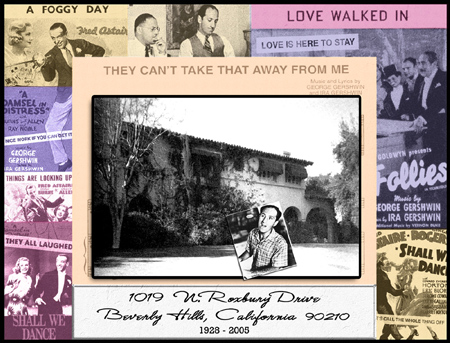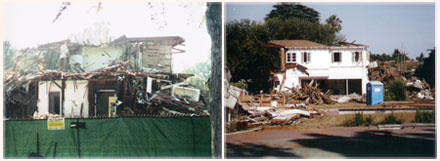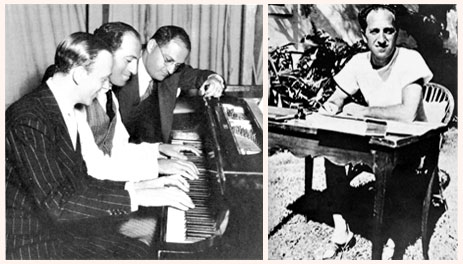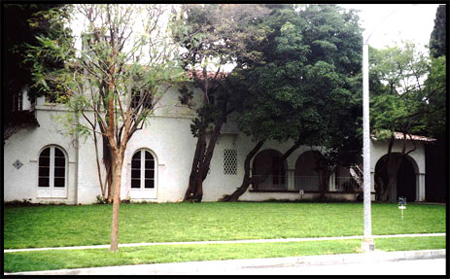|
|
|
 |
Commemorating 1019 N. Roxbury Drive
While the house at 1019 North Roxbury Drive is no longer standing, it can be revisited in memory. The stately mediterranean built in 1928 stood poignantly as a reminder of a vibrant world of glamour and grace that once existed behind its vine-covered arches. Through the lives of the celebrated people who called this house their home, 1019 North Roxbury Drive told the story of Hollywood and held a unique and important place in its history.
However, in the summer of 2005, with no preservation ordinance on the horizon, the City of Beverly Hills issued a demolition permit to have the house and the entire property razed. This was good news for the developer who had a green light for his next "Persian Palace." It was sad news for the many who fought to save the house. 1019 North Roxbury Drive was certainly not the first of "Old Hollywood" to fall victim to the neighborhood wrecking ball. It joined a long list of celebrated residences including the legendary Pickfair - that had been demolished in Beverly Hills, where the rights of property owners have consistently prevailed over any reverence for the past. |
|
 |
|
"1019" is now just a number on a curb of a street that was once the most glamourous and magical in Beverly Hills. North Roxbury Drive was once the "Street of Stars" where one might see Jimmy Stewart walking his dogs, Jack Benny signing autographs and Lucille Ball handing out Halloween candy.
1019 North Roxbury Drive was often referred to as the "George Gershwin house", though he had lived there for less than a year. Before him, the house was home to silent screen star Monte Blue, then crooner Russ Columbo. After the Gershwins, it was owned by band singer Ginny Simms who sold the house to the legendary Rosemary Clooney who lived there for over 50 years. She had seen the changing face of North Roxbury Drive - the stars had passed and their homes were soon to follow. At the time of her death in 2002, "1019" was one of the few original homes still standing.
While George Gershwin's time on North Roxbury Drive was so brief, it was what transpired in that 11-month period (1936-1937) that linked him so closely to the house. After the failure of "Porgy & Bess", the Gershwins left New York and set their sights on Los Angeles to write songs for the Astaire-Rogers movies which were so popular at the time. In August, 1936, George, Ira and Lee (Ira's wife) moved into the spacious home on North Roxbury Drive with the tennis court and swimming pool. It quickly became the gathering place for their New York expatriate friends - Lillian Hellman, Oscar Levant, Harold Arlen, to name a few - all enjoying the California lifestyle. The lush backyard on a given day might find Moss Hart, Harpo Marx, Paulette Goddard poolside, composer Arnold Schoenberg playing tennis, Fanny Brice planting night-blooming Jasmine. There were dinners and poker games in the evenings and amidst the social festivities, there was plenty of work. The Gershwins began with the Astaire-Rogers "Shall We Dance", followed by the Astaire picture, "A Damsel in Distress" and finally, Sam Goldwyn's "The Goldwyn Follies." |
|
 |
Despite an auspicious beginning, this became an increasingly difficult period in George Gershwin's life, personally. However, it was during this brief time, at the house on North Roxbury Drive, that he created the majority of his film music - immortalized songs like "They All Laughed", "Let's Call the Whole Thing Off", "They Can't Take That Away From Me", "A Foggy Day", "Love Walked In" and "Our Love is Here to Stay", whose verse he never lived to complete. George Gershwin died of a brain tumor on July 11, 1937 at the age of 38.
|
|
 |
|
While Rosemary Clooney cherished the Gershwin connection, after her death in 2002, there was concern for the house, and a campaign began to save it. In 2005, when a new owner made his intentions clear to demolish the house, many came forward to fight for its preservation - individuals and organizations like
the Los Angeles Conservancy, The Society of Composers and Lyricists, ASCAP, and B'nai B'rith. Although the Beverly Hills City Council continued to resist the adoption of a preservation ordinance to protect its cultural and historic treasures, there was reason to be cautiously optimistic. While famous people had lived in so many Beverly Hills houses, this was not simply a "celebrity house." Because Gershwin was a composer, and worked from home, and created timeless film works from his home, the house could be eligible for historic preservation, based on cultural merit. Letters poured into the office of Beverly Hills Mayor Briskman asking that the granting of a demolition permit be delayed so that the issue of preserving the house could be fully considered. Form responses were sent in June from the Beverly Hills Director of Community Development saying that "no formal plans have been proposed for the property." Ken Bernstein, Director of Preservation Issues for The Los Angeles Conservancy, called to request a hearing. With no response forthcoming, On August 2, 2005, he again called the Beverly Hills Planning Department. He was told off-handedly that the demolition permit had been issued and the house was already demolished.
Sadly, and ironically, the very week "Parade" magazine ran the spread, "Tell America's Story" Preservation Award Contest, featuring the New York building where a 25-year-old George Gershwin had composed "Rhapsody in Blue" , the house on North Roxbury Drive lay in ruins. |

Click to Enlarge
|
|
|